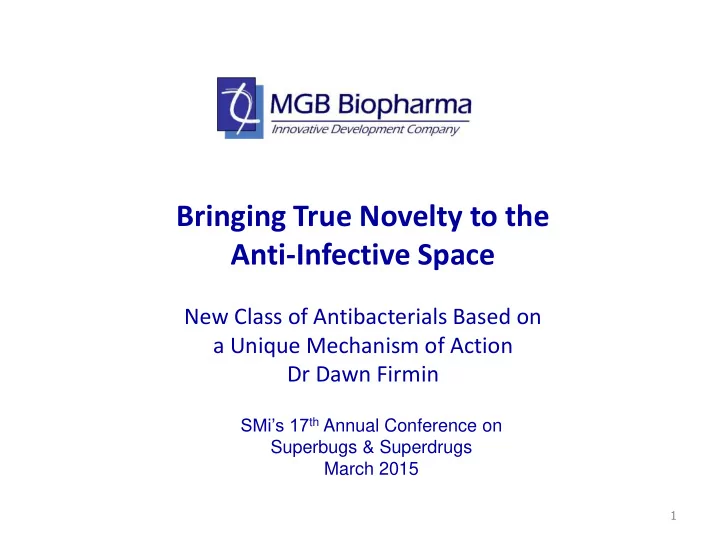

Bringing True Novelty to the Anti-Infective Space New Class of Antibacterials Based on a Unique Mechanism of Action Dr Dawn Firmin SMi’s 17 th Annual Conference on Superbugs & Superdrugs March 2015 1
Contents • MGB Biopharma Limited • M inor G roove B inders • Clostridium difficile • MGB-BP-3 Oral Programme – Non-clinical Pharmacology – Non-clinical Safety – Clinical • Summary • Thanks 2
MGB Biopharma Limited • Founded in Glasgow April 2010 • Based on the University of Strathclydes DNA M inor G roove B inders • Platform hosts a novel class of anti-infectives • Completely new mechanism of action distinct from current antimicrobial drugs • MGB Biopharma’s anti-infective platform provides development opportunities for managing Gram-positive, Gram-negative, viral, fungal & parasitic infections • Lead compound, MGB-BP-3 , is being developed for oral, intravenous and topical preparations 3
MGBs Novel Mode of Action • MGB-BP-3 binds A-T rich sequences in the minor groove of bacterial DNA via a sequential & conformational process that interferes with transcription and alters genetic regulation • MGB-BP-3 does not inhibit bacterial DNA replication • MGB-BP-3 acts at multiple points and affects numerous Binding of MGB-BP ligand to the DNA minor groove; NMR-derived structure genes 4
MGBs Selective Toxicity Against Bacteria Mammalian Cells Effect of AIK-20/25/1 on HS27 Cells 120 IC 50 > 30 M 100 • No toxicity observed in Cytotoxicity (% Control) n=4 80 mammalian cells at 60 40 concentration tested 20 0 -8 -7 -6 -5 -4 • Selective toxicity of Log Concentration (M) MGB-BP-3 in bacterial The Effect of AIK-20/25/1 in the Bacterial Cells Antimicrobial Assay Against S.aureus 07/02/07 cells e.g. S. aureus 150 n=4 0.7 M % Control 100 50 0 -8 -7 -6 -5 -4 -3 Log conc (M) 5
MGB-BP-3 Development MGB Biopharma’s current programmes: 1. Oral MGB-BP-3 for treating C. difficile infections (CDI) 2. Intravenous MGB-BP-3 for treating Gram-positive infection 3. Topical MGB-BP-3 for eradication of Gram-positive carrier states • MGB-BP-3 is the first compound from the MGB platform, with strong activity against Gram- positive pathogens • Oral MGB-BP-3, aimed at CDI, is about to start clinical development 6
Clostridium difficile CDC Statistics Statistics from the most recent CDC Drug Resistance Threat Report (2013) 1 highlights the number of illnesses and deaths caused by antibiotic resistant bacteria, and how many of these are attributed to Clostridium difficile 2014 statistics for the UK were reported as approximately 6,500 Clostridium difficile cases 2&3 1. www.cdc.gov/drugresistance/threat-report-2013 7 2 & 3. www.hps.scot.nhs.uk & www.gov.uk/government/organisations/public-health-england
Clostridium difficile Current Treatment Current treatment options are limited • Until 2010 launch of DIFICID (fidaxomycin – Optimer/Cubist/ Astellas) oral metronidazole & vancomycin were the only options for treating CDI • Oral metronidazole is generally used first in mild cases as it is generic; in addition it does not encourage appearance of vancomycin-resistant enterococci (VRE). Vancomycin is only used in severe cases or non-responders • Utility of these antibiotics is limited due to recurrence; either re-infection with same pathogen or new infection 8
MGB-BP-3 Activity Against C . difficile MGB-BP-3 concentrations Single oral dose 100mg/kg MGB-BP-3 20h post C. diff infection Caecum Small Intestine Colon Plasma 9
MGB-BP-3 Activity Against C. difficile Activity of MGB-BP-3 against C. difficile compared with vancomycin Hamster model of CDI showed that MGB-BP-3 reduced C. difficile CFU/g in the gut and was superior to vancomycin Sporulation studies showed MGB-BP-3 was superior to vancomycin in reducing C. difficile spores CFU/mL 10
MGB-BP-3 Safety Profiles Species/Cell line Dose Route Findings 10 -6 to 10 -5 M CHO-hERG In vitro Oral: 90 mg/kg, Rat Oral 180mg/kg, and 360mg/kg No abnormalities observed from Oral: direct drug effects 90 mg/kg, Rat Oral 180 mg/kg, and 360 mg/kg Oral: 44 mg/kg Dog Oral 111 mg/kg 211 mg/kg Species Dose Route Duration Findings 180mg/kg/day, No toxic effects Rat 360mg/kg/day and Oral 14 days NOAEL 720mg/kg/day 720mg/kg/day NOAEL (male dogs) Dog 76mg/kg/day Oral 14 days 59mg/kg/day 11
MGB-BP-3 Clinical Development Programme • Single Ascending Dose (SAD) Cohort Study session n=2 n=2 n=2 n=2 1 DL 1 DL 1 DL 1 Placebo 1 2 DL 2 DL 2 Placebo DL 2 3 DL 3 Placebo DL 3 DL 3 1 DL 4 DL 4 DL 4 Placebo 2 2 DL 5 DL 5 Placebo DL 5 3 DL 6 Placebo DL 6 DL 6 • Multiple Ascending Dose (MAD) Cohort n=6 n=2 1 DL 1 Placebo 2 DL 2 Placebo 3 DL 3 Placebo • Phase I completion End 2015 12
MGB-BP-3 Summary • New class and novel Mode of Action • Potent activity to Clostridium difficile and a range of aerobic Gram-positive bacteria • Superior activity to vancomycin • Oral programme for the treatment of Clostridium difficile infections about to enter Phase I • Development of intravenous formulation for the treatment of systemic Gram-positive disease is near POC completion • Development of topical formulation for managing carriage – feasibility testing 13
Acknowledgements Funding Entities: Archangels Investment, Tri-Cap, Barwell, SIB, Innovate UK University of Strathclyde: The Lab of Prof. Colin Suckling NHS Lanarkshire: Consultant Clinical Microbiologist Dr Stephanie Dancer 14
Supporters & Agency Involvement Thank you for your attention! 15
Recommend
More recommend